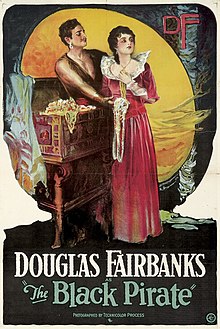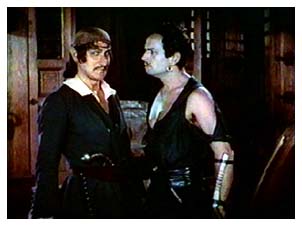There are certain films that become truly surprising, years after their release, for reasons that have absolutely nothing to do with its storyline or acting; The Black Pirate, Albert Parker's 1926 swashbuckler starring Douglas Fairbanks, has become surprising because it is a silent film that just so happens to be in Technicolor (albeit two-tone, but Technicolor nonetheless). One of a series of swashbuckling vehicles for Fairbanks released during the 1920s, The Black Pirate casts the athletic superstar as a young Duke seeking revenge for his father's death by taking the guise of a unnamed buccaneer and joining the company of pirates that did the deed.
A group of pirates blow up a captured ship, via the ship's powder magazine, with all of the occupants still on board. The ship's sole survivors, a Duke and his son, are washed ashore on a deserted island; the father soon dies, leaving his signet ring and dukedom to his son, who vows to avenge his father's death. Through a mixture of coincidence and convenience, the pirates disembark on the same island to bury their horde of treasure. The son, adopting the mysterious (and catchy) moniker of the Black Pirate, walks up to the pirates and proclaims his desire to join the crew. Following the proving of his worth (he has a victorious duel with the captain and he captures a large ship singlehandedly), the crew enthusiastically endorses their new recruit as fit for being their new captain, much to the dismay of the previous first mate. What follows is a series acrobatic fights, the predictable wooing of a for-some-reason-their princess, and the inevitable revelation of his true identity.
The Black Pirate, is one Fairbanks' weaker swashbucklers in terms of both plot and character. While almost all silent films rely on formula, formula does not have to be used in a boring manner: and The Black Pirate certainly uses it in a boring manner. Absolutely nothing distinguishes it from the countless other revenge on the high seas flicks that have been released over the years, except for Douglas Fairbanks. The plot of the film boils down to one clichéd scene after another, with a damsel in distress, portrayed by Billie Dove, thrown in for good measure. Douglas Fairbanks is at his uncannily acrobatic best here (some of his stunts are jaw-dropping), though it is a shame he can't elevate the material beyond the piece of (mildly) diverting fluff it is.
The real appeal of The Black Pirate lies in the fact that it is an intriguing curio from the silent era; it is one of the first films to be released entirely in color, albeit in two-tone Technicolor (which has a limited spectrum in comparison to later Technicolor). In fact, Fairbanks, who was heavily involved with the film's production, invested a considerable amount of money in developing the process that made color films a reality. The Black Pirate was recently selected for preservation in the National Film Registry: it did not get that recognition because of its merits, it got it because of its (very) early use of Technicolor.
The Black Pirate is not a particularly good silent swashbuckler, especially when compared with other Fairbanks films, but it is a fairly competent if underwhelming pirate flick. The film's primary appeal is the viewing of a 1920s silent film in color; the strangeness wears off eventually, but it is enough to make it worth a watch if you have an interest in early cinema.
5/10
Note: This review was previously posted on another blog I wrote.


No comments:
Post a Comment